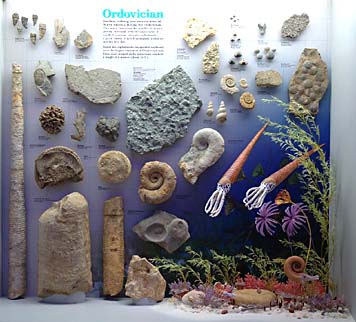
Ordovician Fossil Case,
Illinois State Museum Exhibit
We based this reconstruction on fossils from the Platteville and Galena
Limestones of northwest Illinois.
490 - 443 Million Years Ago
Ordovician Period
Shallow, shifting seas covered most of North America during the Ordovician. This was a time when the number of species greatly increased, with the appearance of corals, bryozoans, crinoids, cephalopods, a great variety of new brachiopods, trilobites, and the first fish. Squid-like cephalopods were the largest creatures in Ordovician seas. Their cone-shaped shells sometimes reached a length of 5 meters (about 16 ft.).
The sea floor was covered by calcium carbonate mud produced by the breakdown of "stony" algae and animal remains. Bryozoans and algae trapped the sediment to form small mounds. The mounds protected animals, such as brachiopods, corals, crinoids, starfish, mollusks, and trilobites.
It is difficult to determine all of the species that may have lived here. Most soft-bodied organisms, such as plants or worms, are not preserved in the fossil record. Impressions or traces of them are sometimes found. Receptaculitids are common in the rocks from this area. Resembling a sunflower center, these were once thought to be sponge fossils. Some scientists now think they could have been colonies of algae with hard skeletons.
For more on Ordovician geology, click on the second button below.